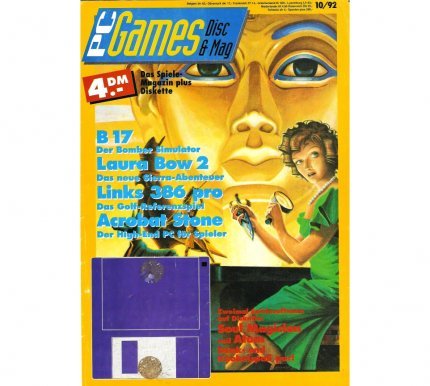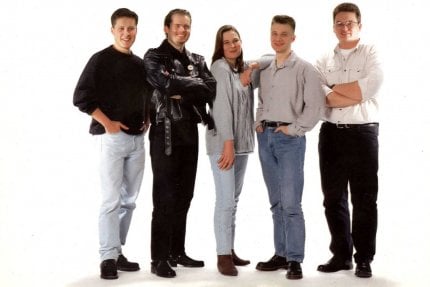30 Years of PC Games: Journey through the History of the Magazine – Part 1

It’s that time again. The PC Games celebrates its anniversary, it is 30 years old. We know what has to come next: an anniversary article, colorful and upbeat, in which we can really celebrate… right? But it’s not that easy. In three decades you not only experience beautiful things, like every magazine we have also experienced many ups and downs. But: They still exist, the good old PC games – and today they are so much more than they used to be. A proven magazine, a modern website, a popular YouTube channel, a lively community and, more recently, a podcast again. In short: a brand that we are really, really proud of. But the way there was long: In this multi-part special, we invite you on a journey through the eventful history of PC games. Accompany us through successes and setbacks through 30 years of PC games.
In the first part of our special we take a long look back at our roots. How did PC Games get started back then, what distinguished the first issues, who was there? Then it’s full throttle into the CD-ROM age, into the era of cutscenes and the triumph of the first-person shooter. Towards the end we finally end up in the late 90’s when 3D accelerators were to change everything.
From Sunday we can also offer you our special as an extra long video. You will also find our other series parts here shortly.
First part – From the floppy disk to the 3D age
It’s the year 1991. Christian Geltenpoth, founder of the Computec publishing house and editor-in-chief of Playtime, develops the idea for two new issues that are explicitly aimed at PC and Amiga buyers. The names are discussed at length, but in the end the simplest solution is decided upon: the magazine sisters are named Amiga Games and PC Games.
That’s how it started

Starting signal: The first edition 10/92 of the PC Games with diskette and Laura Bow 2 on the cover.
Source: PC games
The first PC games found their way onto retail shelves in September 1992 at a slim introductory price of 4 DM. (For the younger ones among you: that’s four German mark). There are 100 pages full to the brim, most of them in colour. But the highlight is on the front of the cover: the cover disk that accompanies every issue. An impressive 1.44 MB can be accommodated on the 3.5″ data carrier, the space is divided between demo versions of new PC games, patches, levels, shareware or small extras. So you get something for your money. Although the much unknown adventure Laura Bow 2 is emblazoned on the cover, the first edition is a success: in the first year, PC Games breaks the mark of around 50,000 copies sold.
Even the first issue offers all the cornerstones that have made us what we are today: At the beginning, the editorial, important reports, preview articles, reports, hardware sections, columns, specials – and of course tests, which have always been the heart of PC games. Also in the first edition: a relaxed corner of letters to the editor, in which the veteran Rainer “Rossi” Rosshirt asks for letters. He should get it: Rainer’s rubric soon developed into a popular contact point for worries, questions, praise and criticism. Thanks to Rossi, the magazine and the community meet right from the start. He will continue to look after the pages for the next 28 years.
Tip: A detailed look at the first edition can be found here in this special!
The old-fashioned way

The originals: Thomas Borovksis, Florian “Stanglnator” Stangl, Petra Maueröder, Harald Wagner and Oliver Menne formed the core team of PC Games in the early years. Not pictured: Rossi.
Source: PC games
Although initially almost two dozen authors wrote for the magazine, the core editors became apparent early on: Thomas Borovskis, Oliver Menne and Harald Wagner are the names and faces that smile at us in most tests. Petra Maueröder has been on board as a freelance editor since the second issue, and with her polished columns and creative opinion boxes, she quickly became the favorite of many readers.
Hard to imagine today: PC games are being created in an era without the Internet, without digital cameras, and without smartphones. Screenshots pose a challenge: they are often supplied by the manufacturer in the form of slides, but when editors need their own images, they retreat to a dark room and artistically photograph the monitor. The developed negatives are then scanned before the layout artists can work with them. Interview questions are faxed to the other side of the world, and the postman brings test samples to the door. The research is done by telephone, and the team picks up the phone again and again and searches for contacts. From the outset, PC Games seeks proximity to the industry and plays to its strengths here: the editorial team learns about many of the trends of tomorrow early on, there are reports worth reading (right in the first issue about Westwood Studios) and games are discussed, many of which were still available back then don’t even know. With background reports and interviews, PC Games goes well beyond simple purchase advice – and hits the right nerve.
Reference-www.pcgames.de